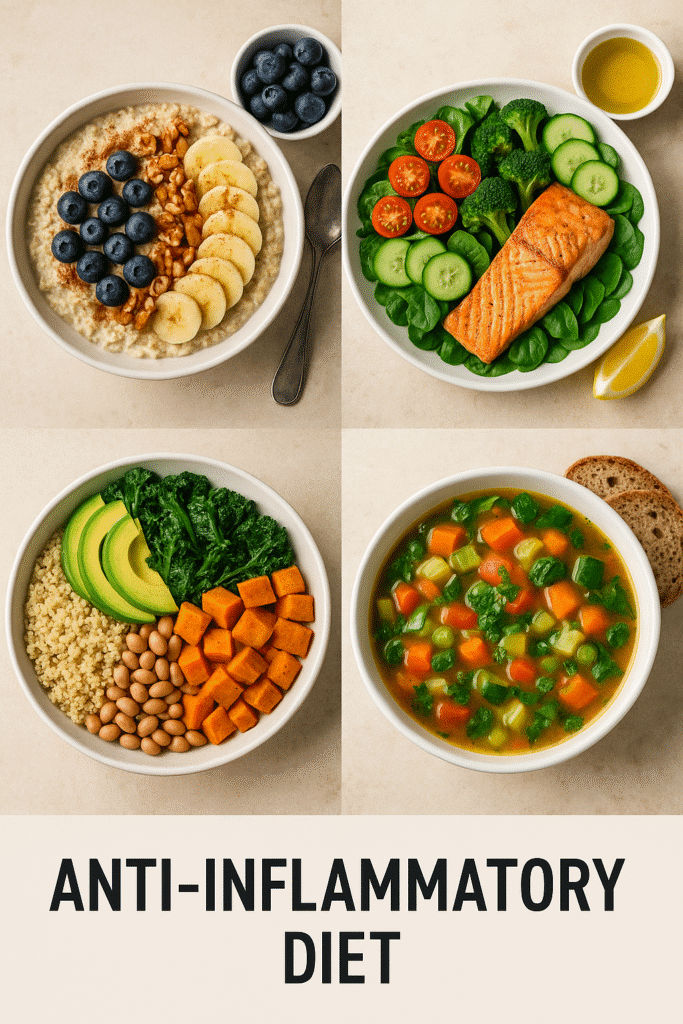Did you know that chronic inflammation is linked to over 50% of health conditions today? That’s wild, right? But here’s the good news: you can fight it with food! This 30 days anti-inflammatory meal plan (2025 edition) is not just about what you eat—it’s a complete lifestyle guide built on flavor, simplicity, and healing. I’ll walk you through the essentials, with foods that nourish from the inside out. Expect practical tips, easy swaps, and meal prep hacks to keep you on track. Whether you’re managing pain, fatigue, or just want to glow from within—this plan’s got your back.

Table of Contents
Table of Contents
What is an Anti-Inflammatory Diet?
So, let me be real. The first time I heard “anti-inflammatory diet,” I thought it was just another buzzword — like some mystical green juice cleanse or something. But turns out, it’s way more practical and, honestly, kind of amazing once you get into it.
The Basics (Without the Fluff)
An anti-inflammatory diet is all about reducing foods that trigger your body’s defense system to overreact. Think: cutting back on stuff like refined carbs, sugar, and trans fats — you know, the usual suspects. Instead, it’s about eating more foods that calm inflammation. Stuff like berries, fatty fish (salmon’s my ride or die), leafy greens, and even spices like turmeric and ginger.
I didn’t go full health nut overnight. I started by swapping cereal for chia pudding and added spinach to everything — even smoothies (yeah, it’s weird at first). Within a week? My joints stopped feeling like rusty hinges in the morning. No joke.
Science-Backed Wins
There’s legit research linking chronic inflammation to heart disease, diabetes, arthritis, and even depression. It’s not just hype — inflammation is like that sneaky villain messing with your body behind the scenes.
So when you eat to fight it, you’re basically telling your cells to chill out. You’re protecting your gut, boosting your immune system, and even improving brain function. Wild, right?
Foods to Embrace
- Berries (blueberries are inflammation’s worst enemy)
- Leafy greens like kale and spinach
- Fatty fish (salmon, mackerel)
- Olive oil (ditch that cheap veggie oil)
- Nuts and seeds
- Spices like turmeric, cinnamon, and ginger
Foods to Avoid (Hard Truth Time)
- Refined sugar (soda, pastries, etc.)
- White bread and pasta
- Processed meats (hello, deli slices)
- Fried foods
- Hydrogenated oils (check those labels!)
My Early Mistakes
At first, I loaded up on “gluten-free” everything thinking it was automatically anti-inflammatory. Big mistake. Lots of that stuff is still highly processed and full of junk. I also underestimated how sugar creeps into everything. Salad dressings? Total sugar bombs.
Once I started reading labels, things got real. And yes, it’s a pain at first. But now it’s like a superpower.
Pro Tips From the Trenches
- Start with one swap a day. Replace toast with sweet potatoes.
- Prep anti-inflammatory snacks so you don’t reach for chips.
- Don’t go broke — buy frozen veggies and bulk nuts to save money.
- Keep it fun. Make turmeric lattes or DIY trail mix with dark chocolate.
Fighting inflammation doesn’t mean eating bland food. It just means feeding your body what it actually needs — and maybe discovering your love for roasted Brussels sprouts in the process.
Why a 30-Day Meal Plan Works Best
I used to laugh at the whole “30 days to change your life” thing. Sounded like one of those late-night infomercials. But after trying it? I’m converted. There’s something powerful about giving yourself just one month to really commit to something — especially when it’s about your health.
The Habit Game is Real
Ever heard that it takes 21 days to form a habit? Well, I always needed a few extra. By 30 days, your taste buds shift, your grocery list changes, and suddenly — you’re not craving pizza every Friday night. I started small: made a calendar, jotted down meal ideas, and batch-cooked some basics on Sundays. That structure saved me on those “ugh, I don’t feel like cooking” days.
By week 2, I had my groove. And by week 4? My body was noticeably less bloated, and I had real energy — like wake-up-before-the-alarm energy. No magic pills. Just real food.
It Removes the Daily Guesswork
Decision fatigue is brutal. Every day asking, “What should I eat?” turns into grabbing a granola bar and calling it lunch. Having a 30-day anti-inflammatory meal plan eliminates that stress. You just follow the map.
I found it so freeing. Planning my meals meant I could enjoy cooking again — without the panic scroll through Pinterest at 5 p.m.
You See (and Feel) the Results
I tracked my meals and symptoms using a cheap notebook. Within 10 days, headaches were fewer, and my skin looked brighter. By the end of 30 days? I’d dropped 6 pounds without counting a single calorie — just from eating anti-inflammatory foods. But the real win? My knees didn’t ache getting out of bed. That was everything.
My Best 30-Day Tips
- Don’t try to be perfect. Miss a meal? No guilt. Just keep going.
- Prep three core meals and rotate ‘em. Variety is great, but consistency is golden.
- Tell a friend or post about it. That tiny accountability helps when motivation dips.
- Keep snacks handy — almonds, boiled eggs, or even hummus and carrots saved me countless times.
Looking back, I wish I’d started sooner. Thirty days go fast. But the results? They stick with you. And honestly, it’s not a diet — it’s a reset your body didn’t even know it needed.
Weekly Meal Plans Overview (Week 1 to 4)
Let me tell you, trying to wing a 30-day anti-inflammatory meal plan was the worst idea I ever had. Week one was a disaster — grocery hauls that made no sense, and meals that didn’t fill me up. That’s when I realized I needed structure. Enter the week-by-week plan that saved my sanity and my budget.
Week 1 – The Detox Ease-In
I called this my “reset” week. I swapped out coffee for green tea (I know… painful), loaded up on greens, and ditched sugar.
- Breakfasts: Berry chia pudding, turmeric oatmeal
- Lunches: Chicken veggie soup, avocado quinoa bowls
- Dinners: Grilled salmon, sautéed spinach, sweet potatoes
- Shopping Tip: Stick to the outer aisles of the grocery store — that’s where the real food lives.
I felt sluggish at first (sugar withdrawal is no joke), but by Day 5 I was sleeping better.
Week 2 – The Flavor Week
Now that my body wasn’t screaming for cookies, I started experimenting.
- Breakfasts: Smoothies with ginger, scrambled eggs with greens
- Lunches: Lentil salad, veggie wraps
- Dinners: Stir-fried tofu, baked turmeric chicken
- Pro Tip: Batch cook grains (like quinoa or brown rice) to mix and match through the week.
Week 2 was when I actually started looking forward to meals.
Week 3 – The Prep Like a Pro Week
By this time, I was in a groove. I picked a meal prep day (Sundays, always), and chopped, marinated, and labeled like a food nerd.
- Breakfasts: Overnight oats, almond butter toast on GF bread
- Lunches: Zucchini noodle bowls, spicy chickpea salads
- Dinners: Baked cod with roasted veggies, turkey lettuce wraps
- Hack: Use mason jars for layered salads — keeps ’em fresh all week.
This week felt like a breakthrough. I wasn’t scrambling anymore.
Week 4 – The Lifestyle Test
I wanted this week to be the one that showed me I could keep going after the 30 days.
- Breakfasts: Smoothies, frittata muffins
- Lunches: Salmon salad, leftover bowls
- Dinners: Sheet pan dinners with everything roasted
- Note: I added back a treat — dark chocolate. Still anti-inflammatory and oh so necessary.
By Day 30, I was legit proud. Not just because my jeans fit better, but because I’d finally figured out what feeding my body right felt like.
Snack Ideas and Substitutions
Confession: I’m a serial snacker. Before I got into anti-inflammatory eating, my snacks were basically sugar bombs or salty carb traps. Granola bars? Little candy bars in disguise. Chips? Empty crunch. So yeah, switching up my snack game was tough at first — but also a total game-changer.
Snacking Smarter, Not Harder
I had to train myself to ask, “Is this going to fuel me or fire up inflammation?” That helped me swap mindless munching for smart bites.
- Go-to snack #1: Chia pudding with cinnamon and berries — sweet, satisfying, and packed with fiber.
- Go-to snack #2: Apple slices with almond butter. Protein + fiber = you’re full longer.
- Go-to snack #3: Homemade hummus and carrots. Don’t knock it till you try roasted garlic hummus — it’s a snack savior.
Sweet Cravings, Handled
I’ve got a wicked sweet tooth. But I learned you don’t have to cut sweetness, just change the source.
- Dates with peanut butter? Tastes like caramel.
- Frozen banana slices dipped in dark chocolate? Yes please.
- Baked cinnamon apples feel like dessert, without the sugar crash.
Savory Swaps That Actually Work
I used to demolish a bag of pretzels like nobody’s business. Now?
- Seaweed snacks or roasted chickpeas for salty cravings
- Handful of walnuts instead of processed trail mix
- Avocado on gluten-free crackers hits every savory note
Honestly, once your taste buds chill out, you don’t even miss the junk. True story: after 3 weeks, I ate an old-school candy bar and hated it. It tasted like a chemical experiment. Never thought I’d say that.
My Lazy Day Backups
Not every snack has to be fancy. I keep these on hand for zero-effort days:
- Hard-boiled eggs (make a bunch at once)
- Celery with sunflower seed butter
- Pre-packed olives (salty, satisfying, no prep)
My Worst Mistake
Thinking gluten-free snacks = healthy. Nope. Some of them have just as much sugar or weird oils. Always check the label — if you don’t recognize the ingredients, your body won’t either.
Tips That Made Snacking Easy
- Prep snack packs on Sunday — keeps you from grabbing junk on busy days.
- Don’t snack because you’re bored. I started asking, “Am I actually hungry?”
- Keep a “safe snack stash” in your bag or car — almonds, clean protein bars, dried fruit.
The right snacks made this meal plan actually livable. No starving. No mood swings. Just steady energy and less guilt. And that, my friend, is a total win.
Tracking Progress and Staying Motivated
Alright, I’ll be honest — I didn’t think I’d need to track anything. I figured I’d “just know” if the anti-inflammatory plan was working. Big mistake. Because by Day 6, I couldn’t tell if I was actually feeling better or just tired from chopping veggies all week. 😂
Why Tracking Helped Me Stay Sane
Once I started jotting down what I ate and how I felt, everything changed.
- I noticed my headaches disappeared after I ditched dairy.
- That bloated feeling? Gone once I cut processed snacks.
- My mood? Weirdly better after I added more omega-3s.
Tracking gave me patterns. And those patterns kept me going — especially on the days I wanted to say “forget this” and order pizza.
How I Tracked Without Overthinking
I’m not into fancy apps (okay, I forget to open them). I just used a cheap spiral notebook.
- Wrote down meals, snacks, and drinks
- Noted energy, digestion, and mood
- Highlighted anything that made me feel “off” or awesome
Simple, no pressure. Just enough to keep me accountable.
Motivation Tips That Actually Worked
- Tiny wins > big goals: I celebrated drinking enough water. Or avoiding the vending machine.
- Photos > scales: I took a weekly pic instead of weighing in. Way less stressful, and the difference shocked me.
- Sticky notes: Yup, I plastered them on my fridge — stuff like “you’ll feel better tomorrow” or “this isn’t forever.”
When I Almost Quit
Week 2, Day 4 — I was hangry, tired, and sick of washing dishes. I snapped at my partner over spinach. 😂
But I flipped back through my food journal and saw how good I’d felt just a few days before. That reminder? It pulled me back in.
Keep It Real With Yourself
You’re not a robot. Some days you’ll want chocolate or skip a meal. That’s fine. What matters is that you keep showing up. This isn’t a punishment — it’s a gift to your body.
What Kept Me Going After 30 Days
I didn’t want to lose the progress. And more than that? I loved how I felt.
- I had more energy.
- I wasn’t snapping at people by 3 p.m.
- And my jeans actually fit comfortably.
So yeah, I kept the food journal going. Not every day, but enough. And every once in a while, I flip through those old notes and smile. Because those scribbles? They remind me how far I’ve come.
Conclusion: Your 30-Day Reset Starts Now
Whew — that was a journey, right? If you made it this far, you’re already ahead of the game. This 30 days anti-inflammatory meal plan isn’t just about what’s on your plate. It’s about how you feel when you stop feeding inflammation and start fueling your body with real food.
Let me tell you — I didn’t think I’d last the month. But now? I can’t imagine going back. Clearer skin, more energy, better sleep… even my moods got a glow-up. And I didn’t do anything extreme. I just showed up every day, did my best, and gave my body what it needed.
So if you’re feeling nervous, overwhelmed, or just plain tired of feeling tired — start here. One meal, one week, one snack at a time. You’ve got this.
✨ And hey — if this guide helped you, do me a solid: Pin it. Share it. Email it to your best friend who’s always complaining about bloating. Let’s spread the good food vibes.


